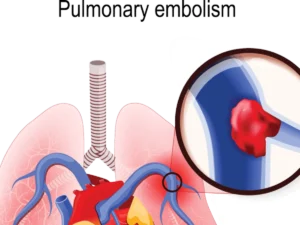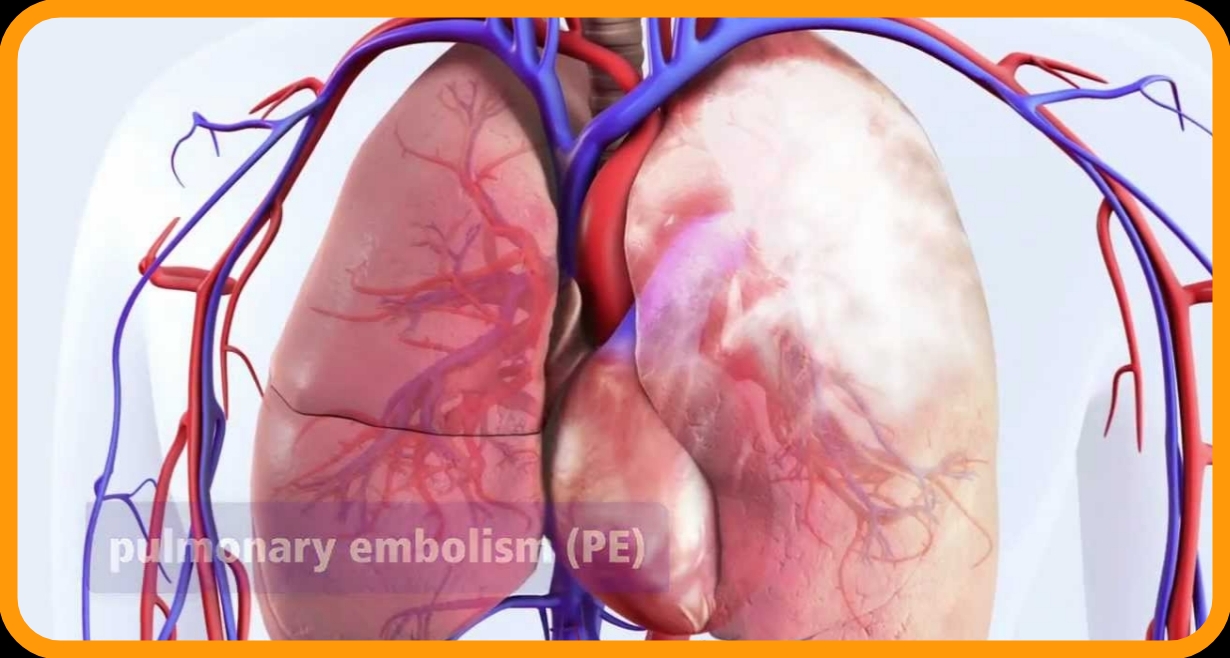Pulmonary embolism (PE) is a serious and potentially life-threatening condition that occurs when a blood clot blocks one or more arteries in the lungs. This blockage can severely impact lung function and overall health. Understanding the meaning, symptoms, causes, and treatment options for pulmonary embolism is crucial for effective management and prevention. In this comprehensive guide, we’ll explore the key aspects of pulmonary embolism, including its signs, diagnosis, treatment, and prevention strategies.

Pulmonary Embolism Meaning
Pulmonary embolism is a blockage in one or more of the pulmonary arteries in the lungs, usually caused by blood clots that travel from the legs or other parts of the body (deep vein thrombosis) to the lungs. This blockage can lead to reduced blood flow to the lungs, causing symptoms such as shortness of breath, chest pain, and, in severe cases, even death.
Pulmonary Embolism Symptoms
Recognizing the symptoms of pulmonary embolism is vital for early diagnosis and treatment. Common symptoms include:
- Shortness of Breath: One of the most common symptoms, often sudden and worsening with physical activity.
- Chest Pain: Sharp or stabbing pain that may worsen with deep breathing or coughing.
- Coughing: Coughing up blood or blood-streaked mucus.
- Rapid Heart Rate: An unusually fast heartbeat (tachycardia).
- Swelling: Swelling in one or both legs, which can be a sign of deep vein thrombosis.
Pulmonary Embolism Causes
The primary cause of pulmonary embolism is deep vein thrombosis (DVT), where blood clots form in the deep veins of the legs or other parts of the body and travel to the lungs. Other causes and risk factors include:
- Prolonged Immobilization: Long periods of inactivity, such as during long flights or bed rest.
- Surgery: Particularly surgeries involving the legs, hips, or abdomen.
- Cancer: Certain types of cancer and cancer treatments increase clotting risk.
- Hormonal Changes: Use of birth control pills or hormone replacement therapy.
- Genetic Factors: Inherited conditions that affect blood clotting.
Pulmonary Embolism Diagnosis
Diagnosing pulmonary embolism involves a combination of clinical evaluation, imaging tests, and blood tests. Key diagnostic methods include:
- CT Pulmonary Angiography (CTPA): The primary imaging test used to detect blood clots in the pulmonary arteries.
- Ultrasound: Used to detect clots in the legs (DVT) that may have traveled to the lungs.
- D-Dimer Test: A blood test that measures the presence of clot-dissolving substances, although not specific to PE alone.
- Ventilation-Perfusion (V/Q) Scan: Evaluates the airflow and blood flow in the lungs to identify potential blockages.
Pulmonary Embolism Treatment
Effective treatment for pulmonary embolism aims to dissolve the clot, prevent new clots, and manage symptoms. Treatment options include:
- Anticoagulants: Medications like heparin and warfarin that help prevent further clotting.
- Thrombolytics: Medications used to dissolve existing clots, typically used in severe cases.
- Inferior Vena Cava (IVC) Filter: A device inserted into the large vein to prevent clots from traveling to the lungs.
- Surgical Intervention: In rare cases, surgical procedures may be required to remove the clot or repair damaged arteries.
Pulmonary Embolism Prevention
Preventing pulmonary embolism is crucial for individuals at risk. Strategies include:
- Medications: For high-risk individuals, anticoagulants or blood thinners may be prescribed.
- Compression Stockings: To improve blood flow in the legs and reduce clot formation.
- Physical Activity: Regular movement and exercises to prevent blood clots, especially during long periods of immobility.
- Healthy Lifestyle: Maintaining a healthy weight, avoiding smoking, and managing chronic conditions such as diabetes.
Pulmonary Embolism ICD-10
In the ICD-10 coding system, pulmonary embolism is classified under the code I26. This code encompasses various types and severities of pulmonary embolism, including:
- I26.0: Pulmonary embolism with acute cor pulmonale.
- I26.9: Pulmonary embolism, unspecified.
Pulmonary Embolism Signs and Symptoms
Understanding the signs and symptoms of pulmonary embolism can facilitate early intervention. In addition to the common symptoms listed earlier, it’s important to be aware of:
- Lightheadedness or Fainting: Due to decreased blood flow and oxygen to the lungs.
- Cyanosis: Bluish discoloration of the skin or lips, indicating insufficient oxygen.
Pulmonary Embolism and the Beatking
The term “beatking” is not commonly associated with pulmonary embolism in medical literature. If you meant a different term or have a specific context in mind, please provide more details for accurate information.
Pulmonary Embolism After Surgery
Pulmonary embolism can occur after surgery, particularly in patients who are immobilized or have undergone major operations. The risk is higher in surgeries involving the legs, hips, or abdomen. Preventive measures post-surgery include:
- Early Mobilization: Encouraging movement and walking as soon as possible after surgery.
- Anticoagulant Therapy: Using blood thinners as prescribed to prevent clot formation.
- Regular Monitoring: Keeping an eye on symptoms and conducting follow-up assessments.
Pulmonary Embolism After Birth
Women can experience pulmonary embolism after childbirth, especially if they have predisposing factors such as a history of blood clots or prolonged labor. Postnatal care includes:
- Monitoring for Symptoms: Vigilant observation for signs of pulmonary embolism in the postpartum period.
- Preventive Measures: Use of anticoagulants or compression stockings as needed.
- Postnatal Care: Regular follow-up with healthcare providers to ensure recovery and manage any risk factors.
Conclusion
Pulmonary embolism is a serious condition that requires timely recognition, diagnosis, and treatment. Understanding the meaning, symptoms, causes, and prevention strategies is essential for managing this potentially life-threatening condition. By staying informed and proactive, individuals can reduce their risk and ensure better health outcomes. If you suspect you have symptoms of pulmonary embolism or are at risk, seek medical attention promptly to receive appropriate care and treatment.



















